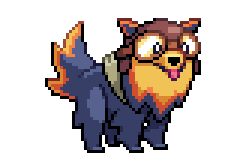
Cassette Beasts

Reviewed 08-28-2024
I was surprised by this one. On the surface it looks like a monster-catching game but it’s much more than that. The story here does way more than it should and the systems in place are so well-thought-out that I was floored. This game has easily made its way into my top favorite games and here’s why.
Cassette Beasts is centered around your player character and your companions. In this world, you and everyone else are stranded. Everyone trapped in New Wirral are castaways from their own realities. Most have no idea how they got there, but have since accepted that there’s no way home and settled down. You are new in town and are first greeted by Kayleigh. She’s the first companion you’ll meet in your adventure and introduces you to the mechanics of the world. She gives you a cassette player and explains how people can transform into beasts by recording them with the device. It’s an introduction that sets up a greater story rather quickly as the first battle leads to the discovery of a new location, an underground train station. There you discover an “Archangel” and have to fight for your life. Upon defeating it, you hear a cryptic piece of a message to spur you into wondering what the rest of the message is. Afterwards you are taken back to town to talk about Archangels and some of the other lore in the world. You are asked to check on a Ranger camp and are then asked to join. On top of this, Kayleigh asks you to visit a small village on the far side of the island so she can check on them. All of these quests weave together into a cohesive narrative. The Ranger quest involves you finding the Captains and defeating them in battle to become a Ranger yourself, while the spooky train stations involve you unraveling the message of the Archangels, all the while getting to know Kayleigh (and future companions) through their stories that eventually loop back into the main story. I never enjoy open world games, so it was surprising that this structure worked for me. I think it relates to the fact that none of these “side missions” are unimportant. They all work into the main story eventually and they make exploring the world rewarding. Speaking of…
The pixel art here is beautiful. The landscapes all have their own vibes and each is very well-made. Because New Wirral is a place between worlds, there are elements from other realities sprinkled throughout that make it really feel like its own unique space. There are electrical junction boxes on poles, British telephone boxes, plus switches and levers littered throughout the world. Some of these aspects make their way into the creature design as well, which really helps sell the hodgepodge of ideas that this world exemplifies.
Beast design is strange, but feels at home in this world. There are crabs with traffic cone shells, walking fish tanks, djinns coming out of glasses of wine and a literal bullet. You can carry a team of six creatures and I always had a hard time choosing because of the plethora of options here. One of my favorites was Scorchfyre, which is basically a fire dog wearing vintage aviator flight goggles. He’s adorable, look at him!
The game has a surprising amount of mechanics as well, not just in the battling either. World navigation opens up as you collect more creatures. They give you powers to traverse the world to reach new areas. For instance, catching the bullet creature allows you to dash and break obstacles. This upgrades your movement substantially, making exploration faster, but they also have a fast travel system. You can fast travel from your map screen to any train station on the map that you’ve visited. This allows for full freedom for exploration as you can easily teleport to a safe location if things get dicey. You’re incentivized to explore every inch of the map and you can tell the developers put a lot of effort into the world design as a result. Traversal usually includes pressing buttons and pulling levers, but the power ups you get from capturing creatures are what really makes it fun.
You can tell that battling was given a lot of the development time as its systems are really deep, without feeling too complex. There are many different types of creatures such as plastic, fire, astral, poison, wind and so forth. Many interactions occur based on common sense, and the first few times you see something happen, the game will explain the mechanic. Here’s an example, if you hit a wind type with a fire type move, it will create an updraft and that will then block further moves from hitting the enemy for a few turns. This is one of many interactions within the game and others follow a similar thought process, but there are a lot of them. Luckily you are given reminders of the type interactions for the first few times you see them, so I never felt lost. Some mechanics are more impactful than others though. If you use an elemental move on an astral type, it will gain increased AP generation. AP (Action Points) are used each turn to attack and each beast gets two per turn. Stronger attacks cost more points and some weaker attacks are free. It’s a system that is relatively easy to get the hang of if you’re fighting in one on one scenarios, but this game is always a two versus two. You and your companion fight side by side against wild creatures and other people. It can be a bit daunting at first, but I got used to it pretty quickly given my experience with the genre. There is one more mechanic to battling that adds an extra layer. That is fusion. Essentially you and your partner fuse creatures to become more powerful. This lasts until the end of the battle or until your HP bar reaches zero. This powerful mode is balanced by a meter that charges this ability. You may not have it available for every battle, unless you manage it well, so it's important to only use it when you really need it. The fused creatures look really cool too!
Catching creatures has some interesting differences on its own as well. You need to record them, but when you are, you are vulnerable. Not the creature, you. Your character has their own HP bar and if it reaches zero, you are knocked out. When you’re recording, if you get hit, your percentage to capture goes down. If you avoid getting hit and instead your partner hits them, the percentage will go up. So you can set up defences on your character by creating a wall or increasing your dodge chance before attempting to record to reduce your chances of getting hit. It makes collecting creatures more dynamic. Plus, when you’re recording, you can’t kill them. If an attack were to drop their HP to zero, it will leave them with one HP and if you succeed in capturing them, they will be defeated. If you fail, the creature will live. I think this is perfectly designed and could see this being implemented in other monster catching games to great effect.
This is an RPG, so you will level up as you complete quests and battles. You gain XP as well as your creatures. Splitting these two progressions, seems superfluous on the surface but it’s done for a very specific purpose. Tapes (Beasts) have star ratings. These can increase up to five and once they reach that level, you can evolve them to a more powerful form. Some creatures have two evolutions to choose from, but most only have one path. The entire party gains XP, whether they participated in the battle or if they fainted. The stats of your beasts are based on you, and your creature’s stats together. This makes swapping out beasts and grinding them up to evolve super easy and advantageous. Other than gaining more levels, your beasts get new moves as well. Leveling up new creatures usually happens pretty quickly, so they gain new moves relatively quickly, making them useful faster. This incentivizes you to swap creatures whenever you find a new one that looks cool.
Another element of the RPG genre present is the upgrading of your kit. You gain Fused Material from completing quests and taking down stronger enemies, which allows you to upgrade your backpack and other things as well. These make some minor changes to your overall stats and allow you to focus more on the style of play you like. If you want to increase your fusion meter generation based on how many creatures you record, you can! It’s not a very complex system, but adds to the value of exploration and quest completion.
Cassette Beasts is a game with a lot of heart. From the character struggles, to the creature and world design, the game is teeming with inspiration and care. Some of the topics explored are so real that I could relate to them on an emotional level. I thoroughly enjoyed exploring and experiencing this game. It’s more than just another creature collecting game and if you give it a try, you’ll see why.










